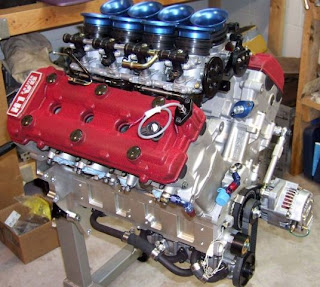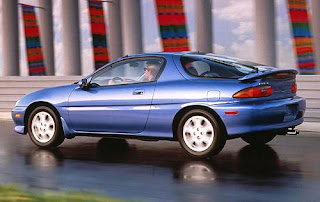Time for a New Engine Design Paradigm?
I just read a story on Autoblog about Hartley Enterprises’ new 2.8 liter 75 degree V8 engine. It’s a combination of two Suzuki Hayabusa four cylinder motorcycle engines. The Hayabusa (formal name GSX1300R) is considered by many to be the fastest production motorcycle in the world. Its 1299 cc (1.3 liter) engine is rated at 175 horsepower, and there are numerous performance upgrades available to improve these figures even further (such as turbo-charging). The V8 built by Hartley Enterprises weighs just 200 pounds, and pumps out 400 horsepower and 245 lb-ft of torque, and revs to 10,000 RPMs. The manufacturer claims that the engine will fit in applications designed for inline four cylinder engines.
Reading about this got me to think about the way engines are currently designed. I’ve always had a thing for small versions of engines that are generally bigger. Basically, the current paradigm in engine design is to alter the number of cylinders but to keep the piston size and stroke (displacement) more or less the same (I4s between 2.0 and 2.5 liters, V6s between 3.0 and 3.8 liters, and V8s between 4.0 and 5.0 liters would all have the same displacement per cylinder).

Instead, the Hartley V8 alters the piston size/stroke and keeps the number of cylinders the same. It gets the street credibility of a V8 (plus, apparently, its horsepower!) yet could potentially have similar economy to a V6 of similar displacement. Heck, it’s hard to find a new V6 less than 3.0 liters anyway, as the newest engines such as the Ford Duratec 3.5 liter, GM High Feature 3.6 liter, and Toyota’s 3.5 liter 2GR-FE are all larger.
Who says that, for example, a Chevy Cobalt shouldn’t be able to enjoy the inherent smoothness (and prestige) of a V8? A small V8 with the same displacement – but half of the per cylinder displacement of the current 2.4 liter Ecotec engines available in these cars – could be a marketing coup. The engine would not have to work as hard to move the cars, and in GM’s case, they cannot build four cylinders that are as efficient as they can V6s and V8s (witness the Corvette coupe’s 400 horsepower LS2 V8 rated at 28 mpg on the highway, while the Cobalt’s 148 horsepower Ecotec 2.2 liter four cylinder is rated at 32 mpg on the highway). Could the Cobalt do better with a V8? If fuel economy and cost concerns could be mitigated, then wouldn’t everyone want a V8?

1993 Mazda MX-3
I always thought the mini V6 that Mazda put into the MX-3 in the early 1990s was sweet. A 1.8 liter 24 valve V6 (though it only put out 108 horsepower, which was on par with contemporary four cylinders, it enjoyed a V6’s smoothness and the prestige of being the smallest production V6 sold in the US. Unfortunately, the market didn’t see it that way, and the engine option was dropped after just a couple of model years. By the way, the V6 MX-3 was rated at 27 mpg on the highway, and the I4 version was rated at 32 mpg.
Alas, cost is probably the one thing keeping automotive engineers from building small displacement V8s and powering their lineups with them. The built-to-order Hartley V8 costs “under $30,000” – in other words, a price at which you could buy two of the aforementioned four cylinder Cobalts. It’s a well-engineered little engine with some extremely high-tech hardware on it.
This is just an idea that I don’t want to give up. Why drive a four-banger when you “coulda had a V8?”




